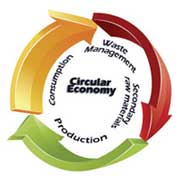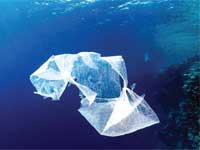Materials News: EU economy going full circle with bioplastics
Also, download this story from the electronic issue here
Europe’s target for a bioeconomy has birthed its latest directive on a circular economy, including its recommendations on the use of biobased plastics, a view that has solicited mixed reviews from industry sectors, including NGOs like Break Free From Plastic movement, according to Angelica Buan in this report.
The EU has finally penned its landmark circular economy plan after wrestling scrutiny from political parties and analysts, alike, to pursue a sustainable, low carbon, resource efficient and competitive economy. After all, it is high time to rethink how wastes are being managed.
The proposed actions will contribute to "closing the loop" of product lifecycles, through greater recycling and re-use, and bring benefits for both the environment and the economy.
The revised legislative proposals on waste set clear targets for reduction of waste and establish an ambitious and credible long-term path for waste management and recycling.
In the package, the EU sets a municipal waste recycling target of 65% and packaging waste of 75% by 2030. These are followed with simplified and improved definitions and harmonised calculation methods for recycling rates throughout Europe. A standard feature is the banning of landfilling of separately collected waste, to reduce landfills to a maximum of 10% of municipal waste, also by 2030.
Meanwhile, a highlight of this policy and to keep the
circular economy mechanics on the roll, is implementation
 of measures to promote reuse of these wastes to create,
what it calls, industrial
symbiosis, meaning,
an industry’s by
product can
be utilised
as another
industry’s raw material.
of measures to promote reuse of these wastes to create,
what it calls, industrial
symbiosis, meaning,
an industry’s by
product can
be utilised
as another
industry’s raw material.
Economic incentives for producers of green products are also provided, as well as for recovery and recycling of wastes from packaging, batteries, electric and electronic equipment, and vehicles.
The EU action plan’s closed-loop economy is also pronged to the region’s 2030 Agenda for Sustainable Development, which is broader in scope, and includes poverty alleviation as well as preservation of natural resources.
As opposed to the conventional linear model, a closedloop economy means that the value of products, materials and resources is maintained in the economy for as long as possible, and the generation of waste minimised. This approach is expected to develop a sustainable, low carbon, resource efficient and competitive economy for the EU.
Plastics’ radius of impact to EU’s economy
Plastics production is a huge industry in Europe, and ranked seventh in Europe in terms of industrial value-added contribution (based on 2012 industry data).
Comprising plastics raw materials producers, plastics converters and machinery manufacturers in the 28 member states in the EU, the industry is a main economic artery, providing direct jobs to more than 1.5 million people in Europe.
It also brought in a trade balance of EUR16.5 billion and turnover of more than EUR340 billion in 2015 , according to a 2016 report, Plastics - the facts, by European plastics association, PlasticsEurope, and the European Association of Plastics Recycling and Recovery Organisation (EPRO). In 2015, Europe’s plastics demand reached 49 million tonnes, with thermoplastics and thermosets as the most widely used types; and the packaging segment garnering the highest share at 39.9%, while electrical/electronics posted the lowest at 5.8%.
Plastics are too valuable a resource that the economy cannot afford to lose them in landfills or in incinerators. In the report, recycling and energy recovery are offered as complementary options to exploit plastics waste, as enablers of a circular economy. These instruments are also recommended to help bridle marine litter.
Road map outlines potholes to fill
Considering that plastics are one of the priority areas in the EUs’ circular economy package, the European Commission (EC) published, in January this year, a roadmap titled “Strategy on plastics in a circular economy”. It covers three main issues and remedies for plastics: high dependence on virgin fossil feedstock; low rate of recycling and reuse of plastics; and significant leakage of plastics into the environment.
Hence, the roadmap aims to reverse these problems by decoupling plastics production from virgin fossil feedstock and reducing its life-cycle greenhouse gas (GHG) impacts; improving the economics, quality and uptake of plastics recycling and reuse and reducing plastics leakage into the environment.
Currently, most conventional plastics are produced from fossil fuel feedstock; plastics production, thus, accounts for an estimated 400 million tonnes of GHG emissions/year (based on 2012 data).
That being said of conventional plastics, it seems logical to use non-fuel feedstock to produce plastics.

Hence, bioplastics are a good fit for the EC strategy, a welcome guideline for Germany-headquar tered European Bioplastics (EUBP), an association representing the bioplastics industry along the entire value chain in Europe.
EUBP concurs that the strategy will steer the plastics industry towards a sustainable economy. Françoi s de Bie, Chairman of EUBP, lauds how the circular economy roadmap prioritises decarbonisation of the plastics industry by employing biobased feedstock.
Bioplastics, which have yet to catch up with traditional plastics in terms of the growth pace, describe two different concepts, according to the roadmap.
Biodegradable plastics are materials that are degraded by microorganisms into water, carbon dioxide (or methane) and biomass under specified conditions, and can be made from organic and/or fossil resources; while biobased plastics are materials made from biological and renewable resources such as grains, corn, potatoes, beet sugar, sugar cane or vegetable oils.
NGOs decry the use of bioplastics in closing the loop
The circular economy agenda is clear and the roadmap is ready to go; but on the emphasis on bioplastics as an instrument to push this ideal, some sectors are sitting on the fence.
Campaigning against plastic pollution is the Break Free From Plastic, backed by over 100 international nongovernmental organisation (NGO) members, including Environmental Investigation Agency, Friends of Europe (FOE), Greenpeace, Marine Conservation Society (UK), Plastic Soup Foundation, Surfers Against Sewage and Zero Waste Europe. It rebuts that the roadmap should focus on reducing and optimising the use of plastics if the circular economy strategy is to make a significant impact.

The EC’s take on waste plastics in marine litter lacks specific measures to deal with the issue; as well the coalition says waste packaging’s role in pollution is attributed more to the lack of consumer awareness rather than addressing a plastic producer’s responsibility.
Break Free From Plastic also countered the plan’s overture on alternative materials to combat pollution. It referred specifically to the hodgepodge of bioplasticsrelated terminologies that confuse consumers, such as degradable, compostable and biobased.
The term bioplastic has been used and understood loosely, maybe due to the complexity of how bioplastics are designed. Not all bioplastics are created equal, and contain varying proportions of biomass components. Hence, not all bioplastics are 100% recyclable or biodegradable.
The term biodegradable can also be tricky because so-called biodegradable plastics do not breakdown easily in home composting; and specialised industrial equipment is required to aid a quick breakdown.
Furthermore, the NGO adds that EC should have refocused on cutting back on single-use plastics while increasing reuse and recycling instead of pitching alternative materials as a solution. It also says that the roadmap does not expound on the need to move away from using toxic chemicals in producing plastics.
“With a massive decrease in the use of single-use
plastics and a sharp increase in reuse and recycling, as
 proposed by the Break Free From Plastic Movement,
the attention on the source of the alternative materials
would be secondary,” says the group.
proposed by the Break Free From Plastic Movement,
the attention on the source of the alternative materials
would be secondary,” says the group.
Delphine Lévi Alvarès, European coordinator of Break Free From Plastic, reiterates, “It is crucial that we reframe the debate around real solutions, take action to dramatically reduce throwaway plastics and acknowledge producer responsibility for a product’s end of life in the design process, rather than focusing on (unsustainable) replacement and recycling.”
Land use under pressure
The Belgium-headquartered FOE (Friends of Earth), the largest grassroots environmental network in Europe, in its report, Land under pressure, contends that an increased consumption of biofuels and bioplastics would increase land demand.
Land requirement for bioplastics in 2016 covers 1.1 million ha globally and by 2019, is projected to reach 1.4 million ha. A rapidly growing share of global agricultural areas is allotted to the production of biomass for nonfood purposes.

FOE stated that Europe is dependent on foreign land areas for its consumption of non-food products. About 65% of the land areas catering to resource requirement are located overseas, such as in Asia, including China, Indonesia and Thailand.
It said that vegetable oils obtained from soybean, palm, rapeseed and sunflower oil form the largest group of non-food products, and accounted for almost 29% of total imports of non-food bioproducts in 2010. These biomaterials are used to produce biodiesel, soaps, paint and plastic.
Recycling made more difficult with bioplastics
Meanwhile, FOE raises the environmental impact related to the design and end-of-life management of bioplastics, including issues with waste prevention, recyclability, biodegradability and composting.
FOE Europe, together wi th Sur fer Foundat ion Europe, Zero Waste Europe, European Environmental Bureau and, the EC and EFTA co- funded body, European Environmental Citizens Organisation for Standardisation (ECOS), have voiced out their take on the issue in an online article published by the Plastic Pollution Coalition.
“Biobased and biodegradable plastics may cause distortion to established collection and recycling processes,” the organisations wrote.
They explained that bioplastics are not all designed to be recyclable in the same way as conventional plastics. Yet, bioplastics enter the plastic recycling stream, and this incurs additional cost of extra sorting between recyclable and non-recyclable, biobased and petroleumbased and mixed source plastics. This scenario not only concerns plastics converters but also stunts recycling rates.
Thus, they recommend that “bioplastics design must be compatible with collection and recycling systems, and to avoid dangerous chemicals and substances”.
Nevertheless, given all the above views, it cannot be denied that bioplastics have been developed on the basis of sustainability and to realise circular economy goals, not only in Europe but in the rest of the world.
Yet, some of the grey areas, particularly in the roadmap, have to be ironed out, with a need to present more comprehensive waste reduction solutions: only then can the loop be closed.
(PRA)Copyright (c) 2017 www.plasticsandrubberasia.com. All rights reserved.



















































